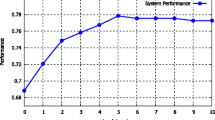Abstract
This paper focuses on identifying the polarity of figurative language in the very short text collected from Social Network Services. Although this topic is not new, most computer scientists have solved this issue by using natural language processing techniques. This seems difficult for non-native English speakers because they have to rely on heuristics in language. Therefore, our target in this work is to find a language-independent approach to solve the problem without using any semantic resources (e.g., dictionaries and ontologies). A statistical method based on two main features (i.e., (i) textual terms and (ii) sentimental patterns) is proposed to determine the sentiment degree of three popular types of figurative language (i.e., sarcasm, irony, and metaphor). We experimented on two Test sets with about 3,800 tweets and used Cosine similarity as the correlation measurement for evaluating the performance. The results show that our Fi-Senti model (Figurative Sentiment analysis model) well performs in determining the sentiment intensity of the figurative language with the best achievement is 0.8952 with sarcasm and 0.9011 with irony.
Access this chapter
Tax calculation will be finalised at checkout
Purchases are for personal use only
Similar content being viewed by others
Notes
References
Amigó, E., et al.: Overview of RepLab 2013: evaluating online reputation monitoring systems. In: Forner, P., Müller, H., Paredes, R., Rosso, P., Stein, B. (eds.) CLEF 2013. LNCS, vol. 8138, pp. 333–352. Springer, Heidelberg (2013)
Davidov, D., Tsur, O., Rappoport, A.: Semi-supervised recognition of sarcastic sentences in twitter and amazon. In: Proceedings of the 14th Conference on Computational Natural Language Learning, pp. 107–116 (2010)
Dragoni, M.: Shellfbk: an information retrieval-based system for multi-domain sentiment analysis. In: Proceedings of the 9th International Workshop on Semantic Evaluation, pp. 502–509 (2015)
Giménez, M., Pla, F., Hurtado, L.-F.: Elirf: a SVM approach for SA tasks in twitter at SemEval-2015. In: Proceedings of the 9th International Workshop on Semantic Evaluation, pp. 574–581 (2015)
Hao, Y., Veale, T.: An ironic fist in a velvet glove: creative mis-representation in the construction of ironic similes. Mind. Mach. 20(4), 635–650 (2010)
Long, N.H., Jung, J.J.: Privacy-aware framework for matching online social identities in multiple social networking services. Cybern. Syst. 46(1–2), 69–83 (2015)
Karanasou, M., Doulkeridis, C., Halkidi, M.: Dsunipi: an SVM-based approach for sentiment analysis of figurative language on twitter. In: Proceedings of the 9th International Workshop on Semantic Evaluation, pp. 709–713 (2015)
Kaur, A., Gupta, V.: A survey on sentiment analysis and opinion mining techniques. J. Emerg. Technol. Web Intell. 5(4), 367–371 (2013)
Medhat, W., Hassan, A., Korashy, H.: Sentiment analysis algorithms and applications: a survey. Ain Shams Eng. J. 5(4), 1093–1113 (2014)
Nguyen, H.L., Jung, J.E.: Statistical approach for figurative sentiment analysis on social networking services: a case study on twitter. Multimedia Tools Appl. (2016). doi:10.1007/s11042-016-3525-9
Özdemir, C., Bergler, S.: Clac-sentipipe: SemEval 2015 subtasks 10 b, e, and task 11. In: Proceedings of the 9th International Workshop on Semantic Evaluation, pp. 479–485 (2015)
Pang, B., Lee, L., Vaithyanathan, S.: Thumbs up? Sentiment classification using machine learning techniques. In: Proceedings of the ACL-02 Conference on Empirical Methods in Natural Language Processing, vol. 10, pp. 79–86 (2002)
Rajadesingan, A., Zafarani, R., Liu, H.: Sarcasm detection on twitter: a behavioral modeling approach. In: Proceedings of the 8th ACM International Conference on Web Search and Data Mining, pp. 97–106 (2015)
Reyes, A., Rosso, P.: Making objective decisions from subjective data: detecting irony in customers reviews. Decis. Support Syst. 53(4), 754–760 (2012)
Reyes, A., Rosso, P.: On the difficulty of automatically detecting irony: beyond a simple case of negation. Knowl. Inf. Syst. 40(3), 595–614 (2014)
Reyes, A., Rosso, P., Buscaldi, D.: From humor recognition to irony detection: the figurative language of social media. Data Knowl. Eng. 74, 1–12 (2012)
Reyes, A., Rosso, P., Veale, T.: A multidimensional approach for detecting irony in twitter. Lang. Resour. Eval. 47(1), 239–268 (2013)
Sang, E.T.K., Bos, J.: Predicting the 2011 Dutch Senate election results with twitter. In: Proceedings of the Workshop on Semantic Analysis in Social Media, pp. 53–60 (2012)
Shutova, E., Sun, L., Korhonen, A.: Metaphor identification using verb and noun clustering. In: Proceedings of the 23rd International Conference on Computational Linguistics, pp. 1002–1010 (2010)
Tsur, O., Davidov, D., Rappoport, A.: ICWSM - a great catchy name: semi-supervised recognition of sarcastic sentences in online product reviews. In: Proceedings of the 4th International AAAI Conference on Weblogs and Social Media, pp. 162–169 (2010)
Veale, T.: Creative language retrieval: a robust hybrid of information retrieval and linguistic creativity. In: Proceedings of the 49th Annual Meeting of the Association for Computational Linguistics: Human Language Technologies, vol. 1, pp. 278–287 (2011)
Veale, T.: Detecting and generating ironic comparisons: an application of creative information retrieval. In: Proceedings of the AAAI Fall Symposium: Artificial Intelligence of Humor, pp. 101–108 (2012)
Veale, T., Hao, Y.: Comprehending and generating apt metaphors: a web-driven, case-based approach to figurative language. In: Proceedings of the 22nd National Conference on Artificial Intelligence, vol. 2, pp. 1471–1476 (2007)
Veale, T., Keane, M.T.: Conceptual scaffolding: a spatially-founded meaning representation for metaphor comprehension. Comput. Intell. 8(3), 494–519 (1992)
Xu, H., Santus, E., Laszlo, A., Huang, C.-R.: LLT-PolyU: identifying sentiment intensity in ironic tweets. In: Proceedings of the 9th International Workshop on Semantic Evaluation, pp. 673–678 (2015)
Acknowledgments
This work was supported by the Ministry of Education of the Republic of Korea and the National Research Foundation of Korea (NRF-2015S1A5B6037297). Also, this work was supported by the National Research Foundation of Korea (NRF) grant funded by the Korea government (MSIP) (NRF-2014R1A2A2A05007154).
Author information
Authors and Affiliations
Corresponding author
Editor information
Editors and Affiliations
Rights and permissions
Copyright information
© 2016 Springer International Publishing Switzerland
About this paper
Cite this paper
Nguyen, H.L., Nguyen, T.D., Jung, J.J. (2016). Fi-Senti: A Language-Independent Model for Figurative Sentiment Analysis. In: Nguyen, H., Snasel, V. (eds) Computational Social Networks. CSoNet 2016. Lecture Notes in Computer Science(), vol 9795. Springer, Cham. https://doi.org/10.1007/978-3-319-42345-6_23
Download citation
DOI: https://doi.org/10.1007/978-3-319-42345-6_23
Published:
Publisher Name: Springer, Cham
Print ISBN: 978-3-319-42344-9
Online ISBN: 978-3-319-42345-6
eBook Packages: Computer ScienceComputer Science (R0)




